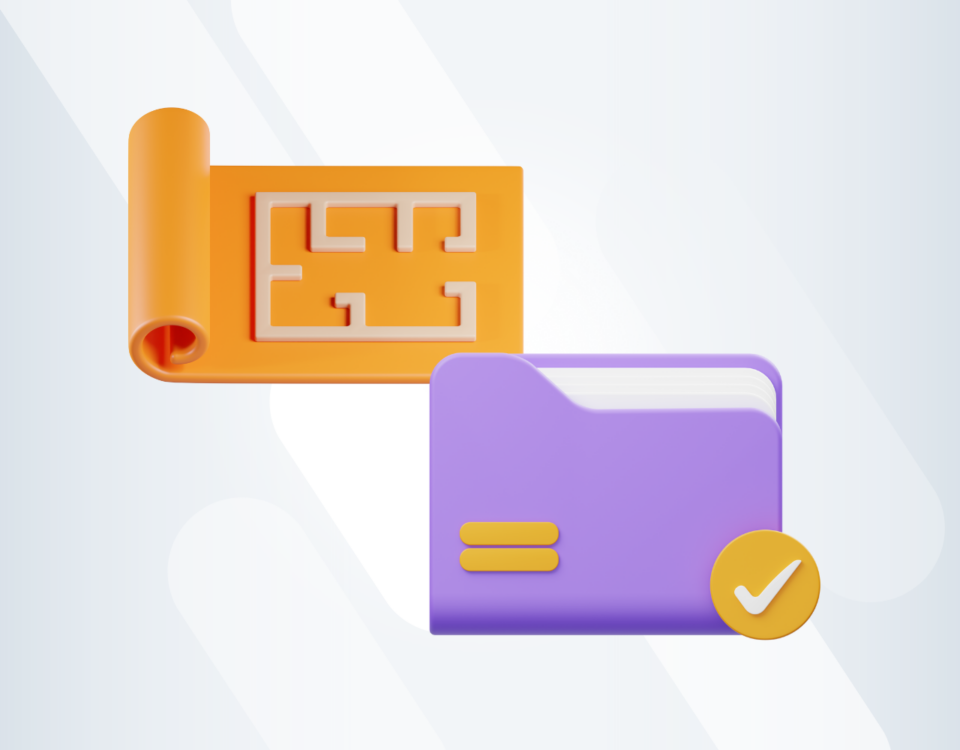Construction Tips, News & Best Practices
How to keep ahead of construction industry trends
We discuss the latest construction industry trends and provide practical advice on how you can stay ahead. If you want to find out more, check out our recent roundup of the best construction job costing tools and software.
As a construction business, your goal is to make better estimates and keep your projects on track and within budget. Seems fairly straightforward, right?
In an ever-changing world, understanding the best way to do that can be a real challenge. When it comes to construction estimating and project management, best practices have changed a lot in the last few years. Much of this comes down to new construction industry trends and technologies offering better ways of working.
But as ever with new technology, the challenge is knowing where to start…
How to get ahead and stay there
There are several key benefits for contractors who successfully stay ahead of new construction trends and technologies.
- Refine your estimating skills
- Provide better, more detailed and data-informed estimates
- Offer a better service to clients
- Keep projects on time and within budget
Of course, not every fad going will be genuinely helpful. So how do you know which technologies and trends to use and which to avoid? Here are some thoughts:
Keep on top of industry publications
One way of keeping track of what’s happening is to pay attention to industry publications. They often cover new construction trends, technologies and processes, with the aim of working out which make sense and which aren’t worth the effort. Here are some of the most important:
Attend industry events
Events and conferences are crucial moments when key industry players get together, share views and decide on the direction of the industry. If you want to get information right from the horse’s mouth, this is the place to be. Some of the most popular UK-based industry events include:
Follow the research
If you’re looking for something a little more quantitative, there are several leading industry publications that specialise in researching new construction trends and technologies. Some of these organisations require a membership - but it’s well worth the price of admission and can make a massive difference in understanding what trends you need to look out for:
- Construction Industry Research and Information Association (CIRIA)
- Building Research Establishment (BRE)
- Royal Institute of Chartered Surveyors (RICS)
- Chartered Institute of Building (CIOB)
Construction industry trends of the last decade
Today, the world of construction is very different to even five or ten years ago. The days of paper-based processes and manual tasks are largely behind us. New technology like cloud computing has enabled companies to hold vastly more data than before and to update and view that information in real time.
This has had a profound effect on the industry, with several key construction industry trends now defining the way we work.
BIM in construction creates an explosion of data
Building information management (BIM) is a common framework through which builders and estimators can present and share information about their projects.
Traditionally, estimates would generally involve a ballpark figure for similar jobs: for instance, all three-bedroom residential builds might be priced at £150,000. In recent years, BIM’s ability to create vastly more detailed construction estimates means it has fast become the industry standard.
BIM in construction aims to reimagine this process. Now, construction estimators generally aim to create bespoke estimates for each project, based on the specific quantities of materials, labour costs and time it will need.
This way of estimating is both a challenge and an opportunity for the industry. While it creates vastly more accurate estimates, the data and time required to produce them is much greater. The right technology can play a massive role in helping you realise the benefits without drowning in data.
‘Always on’ estimating
Cloud technology has also radically transformed the way costs are monitored throughout the project. Once upon a time, it was common for contractors to create just a few estimates for a particular project; perhaps an initial ballpark figure, the official pitch and a few amendments here and there.
Over the last decade, that list has steadily grown. Increasingly, the lines between separate estimates are getting more and more blurred. Information about material prices, availability, labour shortages and more is recorded and communicated near-constantly – due to the wide availability of cloud technology.
That means estimates have become continuous and iterative, with fewer definitive versions and more constant tweaking. This plays a huge role in keeping estimates accurate and up-to-date, but it’s a tough job for the estimator that has to update them.
Instability is the new norm
In the last two years, inflation has become the villain of almost every industry. Prices are now higher than ever and show little sign of returning to their pre-2021 levels. At the same time, successive Covid lockdowns around the world have made supply chains increasingly volatile, with material availability being increasingly unpredictable.
Instability is the new norm – and it doesn’t look like the situation is now likely to settle for a period of years. Against this backdrop, it’s vital that contractors and estimators continue to use the most up-to-date technology and processes to reduce costs and provide greater certainty.
Today’s biggest construction industry trends
Anybody who’s been paying attention over the last few months will know that the next big transformation is now well underway. The hype caused by Chat-GPT earlier this year has caused many to start adopting emerging technologies in their everyday workflows.
Here’s a look at some of the most important emerging construction industry trends and the tangible benefits they can help you achieve.
AI in construction
For years, AI in construction has been the oft-quoted futuristic trend that will one day transform the way we work. In 2023, that future arrived. And while technology like ChatGPT is now being widely used across all industries – the long-term effects of AI on the construction industry remain very much a work in progress.
But while the industry coalesces around a consensus on these new construction industry trends, there are plenty of ways contractors and estimators can use AI today to save time. Here are some examples:
- Automating manual takeoffs
- Checking through estimates for accuracy, broken formulae and sums that don’t add up
- Counting construction symbols in architectural diagrams
- Creating templates for invoices, change orders, proposals and other common documents
Check out our recent deep dive into the many uses of ChatGPT and AI in construction.
VR in construction
VR in construction might not quite have the hype of ChatGPT, but there are plenty of ways it can be used to superpower your estimates and better manage your projects.
The big challenge for estimators has always been visibility over the project on the ground. Before build, that might simply be a case of scouting out the landscape for a better idea of requirements. But during the project, it’s important to update estimates constantly with live information from the ground. This can be pretty tricky if you’re not on the ground – which estimators tend not to be.
Previously, your ability to do these things depended on how often you could organise a visit, or how well project managers communicated. VR in construction gives you the ability to simulate a building site with striking detail. This enhanced visualisation and simulation can make it much easier to accurately forecast the costs and requirements of projects.
5G, IoT and ever-bigger data
Cloud technology has massively expanded the amount of information and data we can process. Now, 5G and advanced data analytics look set to take that to an entirely new level, giving organisations faster and more granular access to vastly more information.
But what does that mean in practice?
- Data, data, data – The ability to understand and visualise more information will mean companies can react much quicker to issues like material shortages, budget overruns and more.
- Real-time updates – Combining 5G with wearable devices and IoT-powered machinery will allow for much more detailed information to be transmitted from site, as well as better proactive monitoring and maintenance of equipment.
- Better estimates – The more detail about costs, timelines, materials and labour you can collect, the better your estimates will be. 5G and advanced data analytics promise more information, delivered quicker as well as better analytical capabilities to quickly understand and use these insights.
New technology has the power to massively improve the way we work, whether that’s AI, data or construction estimating software like Archdesk. But to get it right, you need to know how, where and when to use it.
Get ahead with the right tech
So here’s the challenge for the construction industry today. Cloud technology has made it possible to collate vastly more data about current and past projects, giving us more detailed estimates and more accurate budgets. This has allowed the development of the BIM framework, together with vastly more detailed construction estimating techniques.
At the same time, the development of AI, 5G and IoT will continue to expand the quantities of data being processed across the industry.
This causes both opportunities and challenges. The old ways of working no longer cut it. But without the right technology and tools, contractors and estimators can end up drowning in data without getting any meaningful value out of it.
That’s where Archdesk comes in. Archdesk makes it easy to collate meaningful information about past and future projects in real time, so you can quickly make effective decisions based on it. Here’s how it works:
- Customise and configure reporting dashboards to gather data and easily present the most essential information.
- Present, view and download data across multiple formats, giving you the flexibility to respond quickly.
- Simplified invoice processing reduces manual data entry and the chance of human error.
- Automate generation of invoices, quotes, purchase orders and more
Ready to find out more? Request a demo today.
FAQs
-
What are the construction industry trends for 2023?
The biggest construction industry trends for 2023 currently revolve around new technologies such as AI, 5G, VR and IoT. These promise to make it easier to generate and analyse vital project information in real time.
-
What is the future of the construction industry?
In 2023, the construction industry suffers a challenging outlook due to inflation, supply chain shortages and general financial volatility. Though the worst of this appears to be over, it looks set to continue being a challenge for some time to come.
-
What is the UK construction market outlook?
Due to financial pressures, rising prices and the difficulty in guaranteeing labour supply, the outlook currently for the industry is quite challenging and will continue to be so for the next few months. Despite this, new construction industry trends like emerging technologies offer opportunities to create more accurate estimates and better monitor projects as they progress.
You might also like
February 29, 2024 • 7 min read
Utilizing the human-first approach to construction projects to drive higher results.
July 3, 2023 • 6 min read
8 Best Construction Drawing Management Software (2023): A Comprehensive Guide
Find all the information you need about the construction drawing management software tools available on ...June 14, 2023 • 6 min read
The 11 Best PlanGrid Alternatives (2023)
Looking for a great alternative to PlanGrid software? Check out the 11 best construction software tools ...June 14, 2023 • 4 min read
How to win at CIS 340 and make taxes a breeze
CIS 340 is a legal obligation for contractors. But getting it right isn’t straightforward. Want ...






